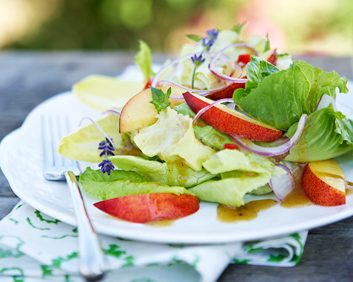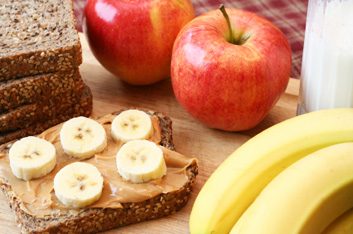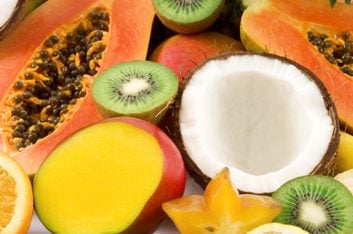
Creative ways to eat fruits and veggies
Sometimes it’s hard to pack all of the recommended servings into a day, especially when you’re heeding the siren call of takeout lunches and restaurant dinners. Let’s call this phenomenon fruit-and-veggie fatigue-you hear your inner scold tell you to eat more plant-based foods, but you just can’t get your act together to do so because you’re either bored by apples or can’t be bothered to find a vegetable-laden main course at a restaurant.
But fear not-there are indeed creative, sensible ways to get seven to eight portions a day. Here’s how.

1. Always eat a salad with a restaurant dinner
Make it a point to order a salad loaded with chopped veggies such as tomatoes and cucumbers along with your usual less-wholesome restaurant choice, and you’ll be getting in a couple of servings of vegetables that you otherwise would likely have forgone. One cup of salad equals one serving, says Calgary-based registered dietitian Gillian Proctor-Ronald.

2. Grate fruit and veggies into food
Try cutting up some mango or pineapple and adding it to yogurt, or toss in some grated apple and muesli. Here’s a neat trick: Grate a thick carrot in about five seconds in the food processor using the grater blade and add handfuls to a potato or bean salad for an extra beta-carotene boost.

3. Snack on them at work
For an adult the recommended amount of servings of fruits and veggies is seven to eight servings, plus, says Proctor-Ronald. “I say ‘plus’ because you’ll get brownie points from a dietitian or doctor if you eat more than this,” she adds. But before you insist that there’s absolutely no way you can eat eight whole servings, remember that a small apple, mandarin orange or small banana counts as one serving, she says, and a navel orange or a big red delicious apple counts as two. Get in four servings before you even eat dinner by having a navel orange as your morning snack, an apple with cheese slices in your lunch and celery and peanut butter after work, she suggests.

3. Snack on them at work
For an adult the recommended amount of servings of fruits and veggies is seven to eight servings, plus, says Proctor-Ronald. “I say ‘plus’ because you’ll get brownie points from a dietitian or doctor if you eat more than this,” she adds. But before you insist that there’s absolutely no way you can eat eight whole servings, remember that a small apple, mandarin orange or small banana counts as one serving, she says, and a navel orange or a big red delicious apple counts as two. Get in four servings before you even eat dinner by having a navel orange as your morning snack, an apple with cheese slices in your lunch and celery and peanut butter after work, she suggests.
4. Add frozen veggies
A great way to add some more vegetables to your dinner or lunch is to throw in something from the freezer. A half-cup of frozen peas can go in a serving of tikka masala when you’re in the mood for Indian cuisine, or it can be added to a macaroni-and-cheese dish, as in this recipe. Your food won’t be overwhelmed by the vegetables, Proctor-Ronald says. “A half-cup of peas is nothing!”

4. Add frozen veggies
A great way to add some more vegetables to your dinner or lunch is to throw in something from the freezer. A half-cup of frozen peas can go in a serving of tikka masala when you’re in the mood for Indian cuisine, or it can be added to a macaroni-and-cheese dish, as in this recipe. Your food won’t be overwhelmed by the vegetables, Proctor-Ronald says. “A half-cup of peas is nothing!”

5. Get out of your fruit rut
“Fruit and veggie fatigue is your fault, not the fault of fruits and veggies,” Proctor-Ronald tells me. Ah, the truth hurts. “The major issue is that individuals get in a rut at the grocery store and pick up the same things week after week: Apples, oranges, bananas, broccoli, cucumbers. There are hundreds of options out there-break out of the rut.” She’s right. I vow to buy at least one vegetable and one fruit I normally don’t. This week, I put persimmons and pattypan squash on my grocery list.

6. Find inspiration in cookbooks
A vegetarian cookbook is a great place to scout for ways to eat more vegetables and fruits. Or try one of the “sneaky chef” cookbooks on the market and find ways to add veggies to your meals without even noticing they are there, Proctor-Ronald suggests.

7. Remind yourself you really need them
Sometimes you really do need a reality check when you’re in vegetable avoidance mode. “Fruits and vegetables are great sources of soluble and insoluble fibre, but they are also loaded with vitamins, minerals and antioxidants that your cheeseburger can never compete with,” Proctor-Ronald advises. She says that she can always tell a client needs to eat more fruit and veggies by their appearance, including sallow skin and breakouts. By adding just a cup of salad and a cup of steamed vegetables to your supper, in addition to including fruits and veggies in your snacks, you’ll easily be up to seven servings a day.
Related:
• 10 weird fruits and vegetables from around the world
• Blog: How do you sneak more veggies in your diet?
• 6 ways to sneak more fibre into your diet
